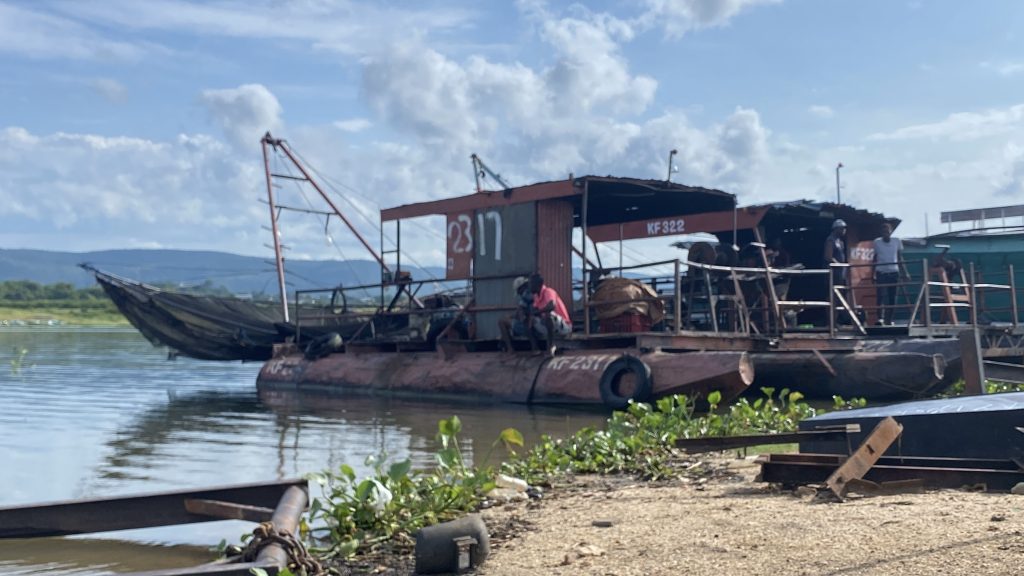
A crate of Kapenta on a scale, a few minutes after offloading on the shores of Lake Kariba, a full crate weighs between 50kg and 60kg but when dried the weight is just a third of this mass.Credit: ConserveZim – John Cassim
John Cassim
The Kapenta fishing industry on Lake Kariba faces a critical decline, with daily catches significantly reduced. The industry’s future depends on effective stock replenishment, primarily through observing the “full moon” fishing break.
However, Chartwell Tanga, Chairperson of the Kapenta Producers Association of Zimbabwe, argues that the standard seven-day break is inadequate. He emphasises that a three-month full moon period is now essential for the Kapenta population to recover and ensure the industry’s sustainability.
“Our thrust as an association is to conserve, hence we sat down in December 2024 and agreed to completely shut down, restrict, kapenta fishing for three months per year for the next five years.
We will have to work with ecologists who will advise which period is conducive to take a break, hopefully this will allow the kapenta to breed effectively,” he suggested.
“We had however recommended that we could start off by shutting down during the rainy season as most people will be on holidays, some visiting or concentrating on planting crops in the fiends,” he added.

A young man from Kariba prepares his Kapenta for sale. These youths are banking on the revival of the Kapenta fishing industry for them to continue working and staying in Kariba their birthright. Credit: ConserveZim – John Cassim
History and Overfishing:
Kapenta, introduced by Zambia between 1967 and 1969, saw its first commercial fishing in July 1973. The introduction of mass fishing using light-attracting lift nets from pontoons significantly increased catch rates. However, this led to an uncontrolled expansion of Kapenta rigs, neglecting the resource’s sustainability.
The industry’s boom in the 1990s fueled infrastructure development in Kariba and across the lake in Zambia. Yet, research by the FAO revealed a drastic decline in Kapenta catches, from 25,000 tonnes in 1990 to under 5,000 tonnes by 2000.
In 2013, Zambia and Zimbabwe agreed to limit fishing rigs to 500 (225 in Zambia, 275 in Zimbabwe). However, this agreement was not enforced, with reports indicating over 1,500 rigs operating daily.
Climate Change and Environmental Impact:
Beyond overfishing, climate change has exacerbated the crisis. Consecutive droughts have lowered water levels, disrupting Kapenta breeding patterns. Kapenta have migrated to river inlets, where water quality and food availability are perceived to be better. However, these areas are vulnerable to illegal fishing, as they require less fuel and offer higher catch rates, leading to rapid depletion.
“They have now moved to the inlets where rivers pour into the lake. We believe this has something to do with quality of water, water temperatures and quality of food that can now be accessed in those areas. Unfortunately, these areas are very easy for unscrupulous fishermen to start fishing in those areas as this require less diesel for the rigs, even the catch is assured to be much better but the result is that we are wiping out all then kapenta instead of conserving,” Tanga explained.

Very soon this harbor in Kariba will be a white ghost and all these rigs will be left to rot if the Kapenta fishing industry is not revamped, Credit: ConserveZim – John Cassim
Regulatory Challenges and Economic Pressures:
The Zimbabwe Parks and Wildlife Management Authority (ZimParks) oversees fishing through permits, licenses, and surveillance. Despite penalties for illegal fishing (e.g., US$2,000 fines and rig confiscation), illegal activity persists.
Kapenta fishers have also voiced concerns about multiple levies, leading ZimParks to offer temporary relief in 2025, discounting fees to US$1,000 per rig and providing payment plans for 2024 arrears.
“Kapenta fishing fees will be discounted to US$ 1000 per rig only for the year 2025. Take note that this is not a reduction in tariff but a conservation support extended to operators only for the year 2025,” the former ZimParks Director General Dr Fulton Mangwanya said in January this year.
Low water levels in Basins 1 and 2 have forced operators to fish in Basin 3, further indicating climate change’s impact. Furthermore, observations reveal that many rigs are dilapidated, causing oil contamination around harbors and potentially throughout the lake. The impact of this oil contamination on Kapenta remains unknown.
Testimonies
Annah Shonhiwa, started the kapenta fishing business with her late husband years back and confirmed the catch has gone down. To her it’s all because of untrustworthy employees who are either stealing the kapenta, selling to buyers on the lake.
“They will tell us that they have gone fishing yet when they return from the Lake they won’t be having anything, we used to catch more than 80 kg per night but today, they are bringing about 20kg,” Annah complained.
Another player Sukros Tauro (40) complained that the catches have dwindled to nearly a quarter which equates to 15 kg.
“We are fishing everyday but when we catch a quarter per night how are we supposed to pay the ZimParks levies, how are we supposed to buy diesel, even pay salaries. I wish the government would help us obtain the solarized rigs and cut the costs on diesel,” he complained.
Amos Magutsa aged 41 acknowledged that climate change has caused serious damage to kapenta fishing.
“The rains are very erratic now, we have main rivers that pour into the lake such as Sanyati, Ume, Nyawodza and Gachekache and others from the Zambian side are drying up. Ordinarily as water enters the lake it brings nutrients that are good for the kapenta. These are our breeding sites but because of the low catches and quarters, operators end up fishing there,” he explained.
